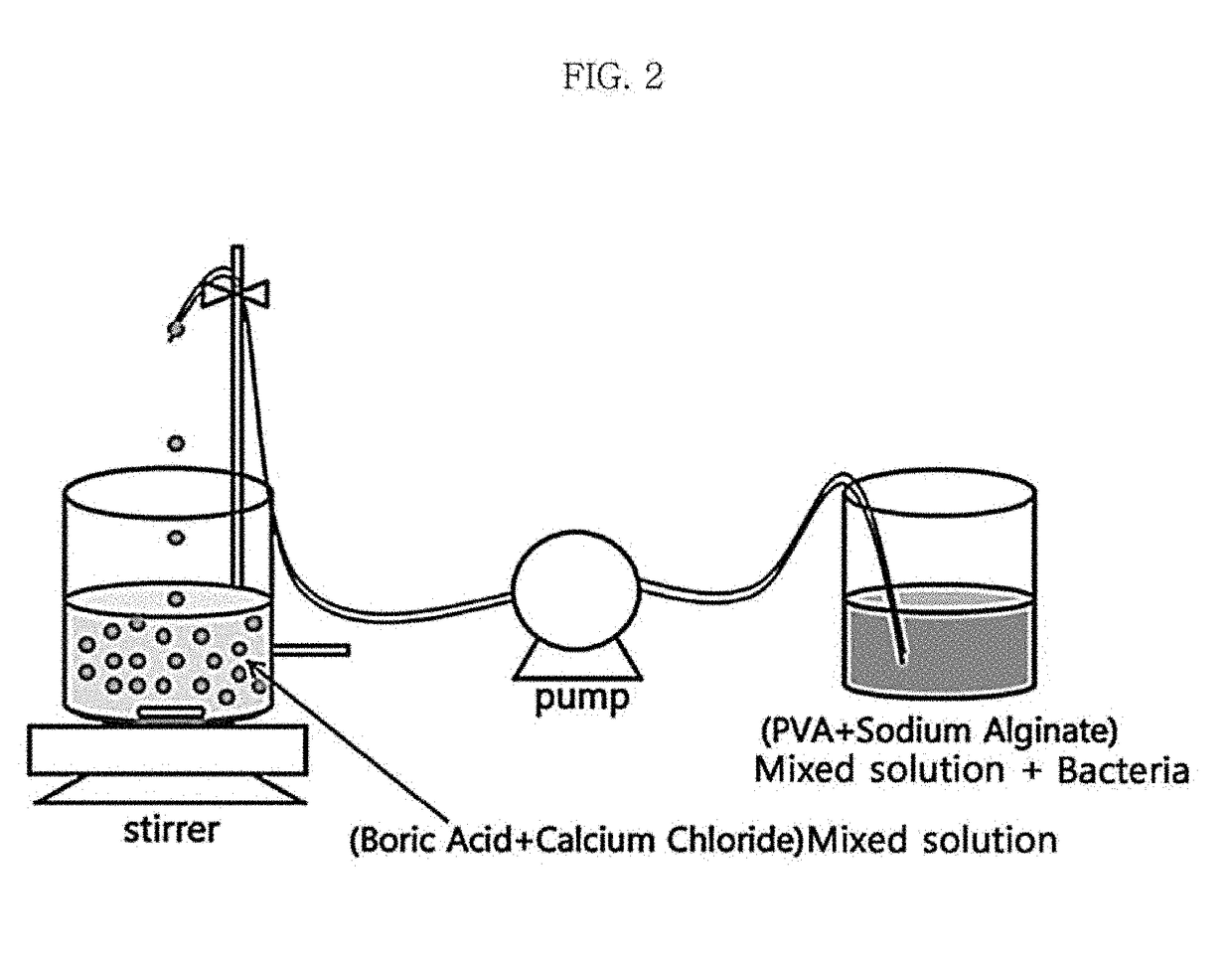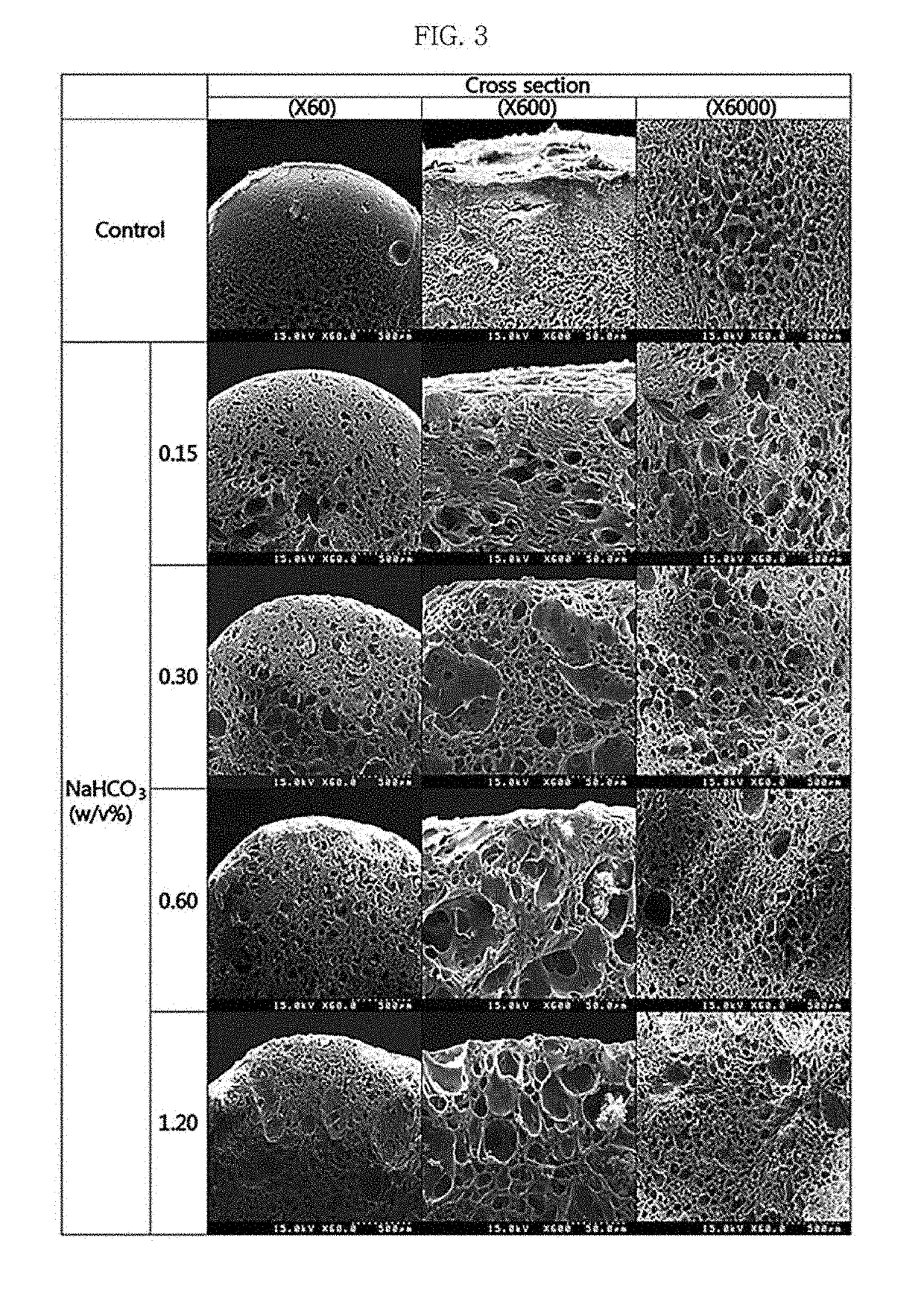Carrier including ammonium oxidizing bacteria immobilized therein and method for preparing same
a technology of ammonium oxidizing bacteria and carrier, which is applied in the direction of inorganic carrier, sustainable biological treatment, biological water/sewage treatment, etc., can solve the problems of large amount of oxygen required, burden on operation cost, and difficulty in maintaining a significantly complicated operating condition, so as to improve the gas permeability and strength of beads
- Summary
- Abstract
- Description
- Claims
- Application Information
AI Technical Summary
Benefits of technology
Problems solved by technology
Method used
Image
Examples
example 1
on of Carrier
[0060]First, 15 g of PVA and 2 g of sodium alginate are mixed per 100 g of distilled water to provide a PVA-alginate mixed solution. Next, sludge containing anaerobic ammonium oxidizing bacteria is added to the PVA-alginate mixed solution. Then, sodium bicarbonate (NaHCO3) is introduced to the PVA-alginate mixed solution mixed with sludge in an amount of 0, 0.15, 0.30, 0.60 or 1.20% (w / v) to provide foaming-beading solutions. After that, each foaming-beading solution is dropped to a saturated boric acid solution containing 0.5-1 g of calcium chloride per 100 g of distilled water to form beads. The beads are allowed to react with 0.5M phosphoric acid solution.
example 2
Swelling Property of Carrier
[0061]FIG. 3 is a scanning electron microscopic (SEM) image of the beads obtained according to Example 1. As shown in FIG. 3, in the case of the beads to which no sodium bicarbonate (NaHCO3) is introduced (see, ‘control’ in FIG. 3), pores are little formed as compared to the beads to which sodium bicarbonate (NaHCO3) is introduced. In addition, as the amount of sodium bicarbonate (NaHCO3) is increased, pore size is increased, as also determined by the porosity test results as shown in FIG. 4. Referring to FIG. 4, as the amount of sodium bicarbonate (NaHCO3) is increased, porosity is increased.
[0062]Meanwhile, after measuring the density of the beads obtained according to Example 1, it can be seen that the density of the beads is increased as the amount of sodium bicarbonate (NaHCO3) is increased up to 0.3% (w / v) as shown in FIG. 5. However, when the amount of sodium bicarbonate (NaHCO3) is higher than 0.3% (w / v), the density of the beads is decreased. It ...
example 3
ability
[0067]The beads obtained according to Example 1 are subjected to a gas permeability test.
[0068]First, dinitrogen gas is injected to each type of beads obtained according to Example 1 at a flow rate of 1 L N2 / min. For reference, when treating highly concentrated wastewater by using anaerobic ammonium oxidizing bacteria, the flow rate of dinitrogen gas produced by the anaerobic ammonium oxidizing bacteria is about 0.44 L N2 / min.
[0069]Referring to FIG. 8, in the case of the beads to which no sodium bicarbonate (NaHCO3) is introduced, the beads have a diameter of 4.49 mm before the injection of dinitrogen gas. However, after the injection of dinitrogen gas, the beads are swelled to a diameter of 13.5 mm and are broken finally. On the contrary, when sodium bicarbonate (NaHCO3) is introduced, the swelling degree of the beads is decreased as the amount of the sodium bicarbonate (NaHCO3) introduced thereto is increased. When the amount of dinitrogen gas is 0.3% (w / v) or higher, the b...
PUM
 Login to View More
Login to View More Abstract
Description
Claims
Application Information
 Login to View More
Login to View More - R&D Engineer
- R&D Manager
- IP Professional
- Industry Leading Data Capabilities
- Powerful AI technology
- Patent DNA Extraction
Browse by: Latest US Patents, China's latest patents, Technical Efficacy Thesaurus, Application Domain, Technology Topic, Popular Technical Reports.
© 2024 PatSnap. All rights reserved.Legal|Privacy policy|Modern Slavery Act Transparency Statement|Sitemap|About US| Contact US: help@patsnap.com










